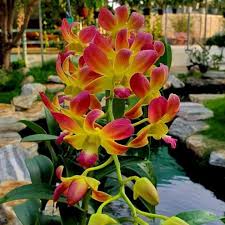# Organizing a Local Dendrobium Orchid Exhibition: A Comprehensive Guide

Organizing a local Dendrobium orchid exhibition can be an exciting and rewarding endeavor for any orchid enthusiast or community organization. This event not only promotes the beauty and diversity of Dendrobium orchids but also fosters community engagement, education, and appreciation for horticulture. In this guide, we will explore the step-by-step process of planning, organizing, and executing a successful Dendrobium orchid exhibition.
## Table of Contents
1. **Understanding the Purpose of the Exhibition**
– 1.1 Promoting Dendrobium Orchids
– 1.2 Community Engagement and Education
2. **Planning the Exhibition**
– 2.1 Setting Goals and Objectives
– 2.2 Budgeting and Funding
– 2.3 Selecting a Date and Venue
3. **Organizing the Exhibition**
– 3.1 Forming an Organizing Committee
– 3.2 Choosing a Theme and Format
– 3.3 Securing Participants and Vendors
4. **Promoting the Exhibition**
– 4.1 Marketing Strategies
– 4.2 Collaborating with Local Media
– 4.3 Utilizing Social Media
5. **Setting Up the Exhibition**
– 5.1 Designing the Layout
– 5.2 Displaying Orchids Effectively
– 5.3 Providing Amenities for Visitors
6. **Executing the Exhibition**
– 6.1 Day-of Coordination
– 6.2 Engaging Activities and Programs
– 6.3 Handling Logistics
7. **Post-Exhibition Activities**
– 7.1 Evaluating the Event
– 7.2 Thanking Participants and Sponsors
– 7.3 Planning for Future Exhibitions
8. **Conclusion**
– 8.1 The Impact of Dendrobium Orchid Exhibitions
– 8.2 Encouraging Continued Interest in Orchids
—
## 1. Understanding the Purpose of the Exhibition
### 1.1 Promoting Dendrobium Orchids
Dendrobium orchids are celebrated for their unique beauty and vast diversity. Organizing an exhibition provides an excellent platform to showcase these exquisite flowers and educate the community about their care, cultivation, and various species.
### 1.2 Community Engagement and Education
A well-organized orchid exhibition can enhance community engagement and foster a love for horticulture. It serves as a space for enthusiasts and novices alike to connect, share experiences, and learn from one another.
## 2. Planning the Exhibition
### 2.1 Setting Goals and Objectives
Before diving into the logistics, it’s crucial to establish clear goals and objectives for your exhibition.
– **Goals**: These might include promoting Dendrobium orchids, attracting local horticulturists, or raising funds for a specific cause.
– **Objectives**: Set specific, measurable objectives such as the number of participants, expected attendance, or funds raised.
### 2.2 Budgeting and Funding
Creating a comprehensive budget is essential for a successful exhibition.
– **Budget Components**: Include expenses such as venue rental, marketing materials, permits, decorations, and refreshments.
– **Funding Sources**: Consider potential funding sources, such as sponsorships from local businesses, entry fees, or grants from horticultural organizations.
### 2.3 Selecting a Date and Venue
Choose a date that does not conflict with other major local events and allows ample time for planning and promotion.
– **Venue Selection**: Look for a location that can accommodate the expected number of visitors and provide the necessary facilities. Options may include community centers, botanical gardens, or local parks.
## 3. Organizing the Exhibition
### 3.1 Forming an Organizing Committee
A dedicated organizing committee is vital for managing different aspects of the exhibition.
– **Committee Roles**: Assign specific roles based on individual strengths, such as marketing, logistics, finance, and participant coordination.
### 3.2 Choosing a Theme and Format
Decide on a theme that reflects the unique characteristics of Dendrobium orchids and appeals to your target audience.
– **Theme Ideas**: Consider themes like “The Colors of Dendrobium,” “Dendrobium in Nature,” or “Orchids and Their Care.”
– **Exhibition Format**: Determine the format of the exhibition, which could include a display of live orchids, educational booths, workshops, or guest speakers.
### 3.3 Securing Participants and Vendors
Reach out to local growers, orchid societies, and vendors to secure participation in the exhibition.
– **Participant Outreach**: Encourage local orchid enthusiasts to showcase their Dendrobium orchids and share their expertise.
– **Vendor Coordination**: Invite vendors selling orchid supplies, plants, or related products to enhance the exhibition experience for visitors.
## 4. Promoting the Exhibition
### 4.1 Marketing Strategies
Develop a marketing plan to create awareness and attract visitors to the exhibition.
– **Promotional Materials**: Create eye-catching flyers, posters, and brochures to distribute in the community.
– **Email Campaigns**: Utilize email newsletters to reach out to local gardening clubs, schools, and community organizations.
### 4.2 Collaborating with Local Media
Engage local media outlets to cover the event and attract a wider audience.
– **Press Releases**: Write and distribute press releases to local newspapers, radio stations, and television channels.
– **Media Partnerships**: Consider partnering with local media for promotions or coverage of the event.
### 4.3 Utilizing Social Media
Leverage social media platforms to reach a broader audience and engage with potential visitors.
– **Social Media Campaigns**: Create event pages on platforms like Facebook, Instagram, and Twitter to share updates and engage with the community.
– **Hashtags**: Develop a unique hashtag for the exhibition to track posts and interactions.
## 5. Setting Up the Exhibition
### 5.1 Designing the Layout
A well-organized layout enhances the visitor experience and ensures easy navigation through the exhibition.
– **Display Areas**: Designate specific areas for orchid displays, educational booths, and vendor stalls.
– **Flow of Traffic**: Consider the flow of foot traffic to avoid congestion and allow visitors to explore comfortably.
### 5.2 Displaying Orchids Effectively
Display Dendrobium orchids in a manner that highlights their beauty and encourages admiration.
– **Creative Displays**: Use creative arrangements, including hanging displays, tables with varying heights, and themed sections.
– **Informational Signage**: Provide labels and descriptions for each orchid variety, sharing information about care and cultivation.
### 5.3 Providing Amenities for Visitors
Ensure that visitors have access to amenities that enhance their experience.
– **Refreshments**: Consider offering light refreshments, such as water, snacks, or local delicacies.
– **Rest Areas**: Create comfortable seating areas where visitors can relax and enjoy the ambiance.
## 6. Executing the Exhibition
### 6.1 Day-of Coordination
On the day of the exhibition, ensure that the organizing committee is present to oversee operations.
– **Set-Up Crew**: Arrive early to set up displays, signage, and vendor areas, ensuring everything is in place before visitors arrive.
– **Welcome Booth**: Set up a welcome booth to greet visitors, provide information, and distribute event programs.
### 6.2 Engaging Activities and Programs
Incorporate engaging activities to enhance the visitor experience and encourage participation.
– **Workshops**: Host workshops on Dendrobium care, propagation techniques, or floral arrangements.
– **Guest Speakers**: Invite experts to give talks on specific topics related to Dendrobium orchids.
### 6.3 Handling Logistics
Be prepared to manage any logistical challenges that arise during the exhibition.
– **Volunteer Coordination**: Utilize volunteers to assist with various tasks, including crowd management, guiding visitors, and answering questions.
– **Emergency Preparedness**: Have a plan in place to address any emergencies, such as first aid or technical difficulties.
## 7. Post-Exhibition Activities
### 7.1 Evaluating the Event
After the exhibition, take time to evaluate its success and gather feedback.
– **Surveys**: Distribute surveys to visitors and participants to gather insights on their experiences and suggestions for improvement.
– **Committee Debrief**: Hold a debrief meeting with the organizing committee to discuss what worked well and what could be improved for future events.
### 7.2 Thanking Participants and Sponsors
Express gratitude to participants, vendors, and sponsors for their support.
– **Thank-You Notes**: Send personalized thank-you notes to everyone involved, recognizing their contributions to the success of the exhibition.
– **Public Acknowledgment**: Consider publicly acknowledging sponsors and participants through social media or local press.
### 7.3 Planning for Future Exhibitions
Use the insights gained from the exhibition to begin planning for future events.
– **Feedback Implementation**: Incorporate feedback from participants and visitors into future planning efforts.
– **Building on Success**: Consider making the exhibition an annual event, enhancing its reputation and community engagement over time.
## 8. Conclusion
### 8.1 The Impact of Dendrobium Orchid Exhibitions
Organizing a Dendrobium orchid exhibition can have a lasting impact on your community. It not only celebrates the beauty of these unique flowers but also educates and engages people in horticulture, fostering a greater appreciation for nature.
### 8.2 Encouraging Continued Interest in Orchids
By providing a platform for education, interaction, and celebration, local orchid exhibitions can inspire ongoing interest and passion for Dendrobium orchids and gardening as a whole.
In summary, a well-planned and executed Dendrobium orchid exhibition can be a memorable and enriching experience
for everyone involved. With careful consideration of each aspect, from planning to post-exhibition evaluation, you can create an event that celebrates the beauty of orchids while strengthening community bonds and fostering a love for horticulture.

